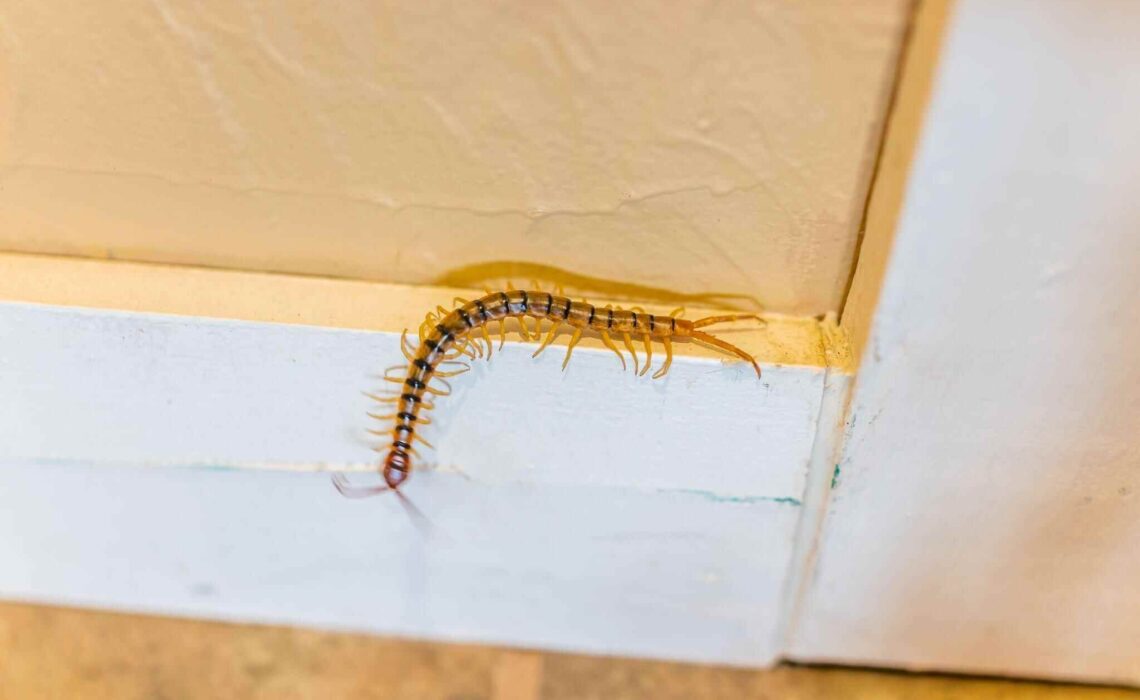From all of the known pests that can infest your home and cause trouble, house centipedes are perhaps one of the most non-aggressive ones that usually don’t require an immediate call to the local pest infestation company. Although not visually attractive for most people, one or two house centipedes in the house isn’t really something to worry about. However, if things get out of hand and house centipedes multiply in your indoor area, you’re in for some headaches.
In this article, we’ll introduce you to this type of pest in detail. We’ll talk you through what house centipedes are, what they eat, what the signs of an infestation are, and how to get rid of them if they become a problem.
What are house centipedes?
Table of Contents
A house centipede is a type of arthropod that is commonly found in homes and other buildings. They belong to the Scutigeridae family, and they are characterized by their elongated, flattened body and numerous legs. They are typically gray or brown in color and can grow up to 1.5 inches long. House centipedes have 15 legs, with the first pair being the longest and the others decreasing in length. They are known for their speed and agility, and they are able to move quickly across walls and ceilings.
House centipedes are nocturnal and are typically found in damp, dark areas of the home such as basements, crawl spaces, and bathrooms. They feed on other insects and arthropods, such as spiders, moths, and silverfish. They are not known to cause any harm to humans, and they don’t bite. They are considered beneficial to have around as they help to control other insect populations.
It’s important to note that even though house centipedes are not harmful to humans, their presence can be unsettling and if you have a severe infestation, you may want to seek professional help to eliminate them.
What do house centipedes eat?
House centipedes are predators and they primarily feed on other insects and arthropods, such as spiders, moths, silverfish, and other small invertebrates that they find in the house. They use their long legs and antennae to locate and capture their prey, which they can catch easily due to their speed and agility.
They are known for their predatory nature and are considered beneficial to have around as they help to control other insect populations that can be harmful or considered pests in the house. They are also opportunistic feeders, and they can feed on other insects like cockroaches, beetles, and other small insects that they find in the house. They can also feed on other small invertebrates such as worms and snails.
Signs of a house centipede infestation
The signs of a house centipede infestation can include:
- Sightings of centipedes – Seeing house centipedes in the home, especially in damp and dark areas such as basements, crawl spaces, and bathrooms. They are nocturnal creatures and are typically more active at night.
- Molted exoskeletons – You may find discarded molted exoskeletons, which are the shed outer covering of the centipede as it grows.
- Damage to walls and ceilings – House centipedes move quickly across walls and ceilings, and you may notice small holes or marks on the walls or ceilings as a result of their activity.
- Presence of other insects – House centipedes feed on other insects, so if you notice an infestation of other insects such as spiders, moths, or silverfish, it could be an indicator of a house centipede infestation.
How to get rid of house centipedes
:max_bytes(150000):strip_icc()/housecent-e4f89c346af6452192d27a90668106fc.jpg)
Image source: https://www.thespruce.com/
If you’re experiencing a severe house centipede infestation and you feel that it’s time to take measures, here are some steps you can take to get rid of the problem.
1. Eliminate moisture
House centipedes are attracted to damp and humid environments, so it’s important to eliminate any sources of moisture in your home. Fix any leaks, use dehumidifiers in damp areas, and ventilate damp spaces such as bathrooms and laundry rooms.
2. Seal up entry points
House centipedes can enter your home through small cracks and holes, so it’s important to seal up any potential entry points. Use caulk to seal gaps around windows, doors, and pipes, and use door sweeps to seal the bottom of doors.
3. Keep the house clean
House centipedes are attracted to food debris and other organic materials, so it’s important to keep your home clean and free of crumbs, spills, and food scraps. Vacuum and mop floors regularly, and take out the garbage frequently.
4. Traps
You can use sticky traps or glue boards to trap house centipedes. Place them in areas where you have seen the centipedes.
5. Professional extermination
If you suspect you have a severe infestation or you can’t get rid of them, it’s best to contact a professional exterminator to help you identify and eliminate the problem.
We hope that this information will come in handy if you spot a house centipede at home.
- How To Create A Safe And Comfortable Home Environment For In-Home Care In Boca Raton? - July 16, 2024
- 10 Trendy Black Nail Ideas To Elevate Your Nail Game - May 6, 2024
- Getting A Free Divorce In Virginia? Here’s What To Expect - April 24, 2024





No Comments